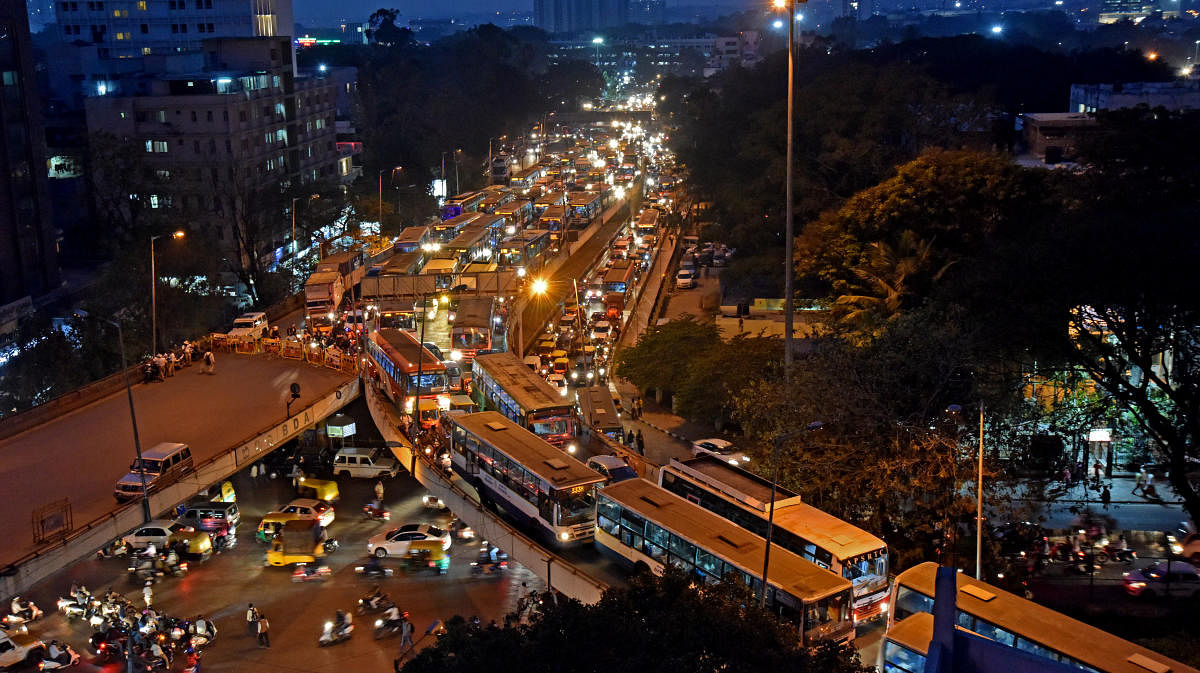
The government has revived the elevated corridor project yet again.
First mooted in July 2018 for a budget of Rs 15,825 crore, the project had run into opposition, but the government is taking it up again.
The Karnataka Road Development Corporation Limited (KRDCL) is inviting tenders from contractors.
Compared to the steel flyover, the 102-km elevated corridor will create almost 10 times more damage, says Srinivas Alavalli, co-founder Citizens for Bengaluru.
The group had launched the #SteelFlyoverBeda campaign.
He says “the elevated corridor is the great-grandfather of steel flyover”.
“The number of Bengalureans commuting in personal vehicles has increased; 16 lakh cars are among the 80 lakh vehicles on the road. This number is higher than the adult population in the city,” he says.
Government policies do not encourage public transport, he alleges.
“From 2013 to 2019, not one additional bus has been added to the BMTC, while every day around 300 cars are being registered. Subsiding tickets is another measure which should be taken,” he says.
Metro rails mostly have just three coaches. In the last 12 years, only 42 km of Metro services have been built. Metro services are not available in areas like Outer Ring Road, Electronics City and Bannerghatta Road, which see a high concentration of vehicles, he notes.
The theory that citizens do not opt for public transport isn’t true, according to Alavalli.
“One can still see people hanging from buses and also waiting in queues to board Metro,” he says.
Despite the flyovers, choc-a-bloc traffic is a reality in Bengaluru.
“According to the induced demand theory, anytime a flyover is added, the number of vehicles travelling on it also increases. And bottlenecks around the flyover are a mess,” he explains.
Activist and co-founder of CfB, Tara Krishnaswamy, believes the 102 km corridor will affect the city “on a much larger scale.”
“It involves larger ecological damage, and a decade of dug-up areas and construction material on the road,” she says.
The social impact of such a project will include loss of business for vendors and shop owners on this large stretch.
She suspects the project will encourage more cars. “For a city sans traffic, the state government should invest in public transport, and that includes bus, Metro and suburban rail,” she says.
Vijay Nishanth, environmentalist and ‘tree doctor,’ wonders why no sustainability study or public consultation has taken place.
While the earlier steel flyover would have led to the city losing around 2,000 trees, the elevated corridor can lead to the green cover being depleted of more than 3,000 trees.
“A High Court order clearly states that any project which can lead to more than 50 trees being cut needs to set up a tree committee. No proper planning can be seen here. The elevated corridor is not a people’s project,” he says.
Elevated corridor encourages cars
“Of the total number of cars on the road, 27 per cent are big cars, four meters or longer, adding to the confusion on the road. About 37 per cent of the total number are diesel cars. Cars are adding to congestion and pollution, yet projects like the elevated corridor are encouraging and creating more space for cars.”
- DT Devare, Trustee, Bangalore Environment Trust
While most activists are frustrated with the new proposal, representatives from Bangalore Environment Trust (BET) have put together inputs for planners.
A study conducted by BET with Divecha Center for Climate Change in IISc and Lakeside Education Trust reveals that smaller suspended particles of SPM (10 to 2.5 microns) are playing havoc with the lungs of the citizens, especially little children.
“The elevated corridor project will significantly contribute to the heat island effect and increase the suspended particulate matter in the city,” says DT Devare, trustee, BET.
The project will result in axing of 3,000 to 5,000 trees aged between 30 to 50 years, which perform unique life supporting duties.
Studies have revealed that a number of heat islands have already been formed and are contributing to an increase in ground level temperature by 5 to 8 degrees Celsius, as compared to the ambient temperature that prevailed just a few years ago.
Devare says claims of the corridor will cater to buses are misleading.
“There can’t be bus stops on the elevated portions,” he says.
Why it’s bad
- Cost doesn’t justify benefits
- Major roads will be in a bad shape for a decade
- Encourages private vehicles
- Business loss for vendors, shops
Where does the corridor go?
The government has broken the proposed elevated corridor into three packages of two, three, four and six lanes. The corridor begins at Baptist Hospital, goes via JC Nagar and Shantinagar to terminate at Central Silk Board. Yes, the notoriously choked Silk Board.